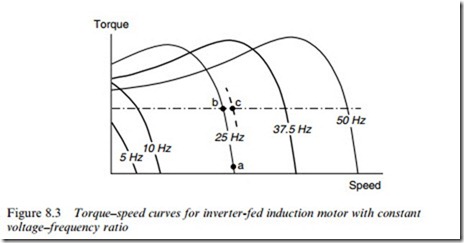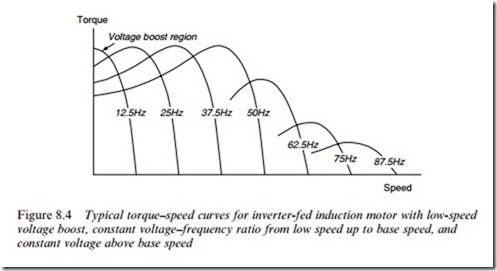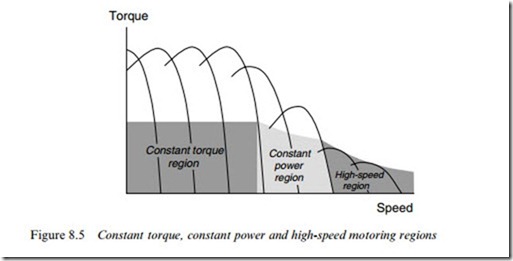TORQUE–SPEED CHARACTERISTICS – CONSTANT V/F OPERATION
When the voltage at each frequency is adjusted so that the ratio V/f is kept constant up to base speed, and full voltage is applied thereafter, a family of torque–speed curves as shown in Figure 8.3 is obtained. These curves are typical for a standard induction motor of several kW output.
As expected, the no-load speeds are directly proportional to the frequency, and if the frequency is held constant, e.g. at 25 Hz in Figure 8.3, the speed drops only modestly from no-load (point a) to full-load (point b). These are therefore good open-loop characteristics, because the speed is held fairly well from no-load to full-load. If the application calls for the speed to be held precisely, this can clearly be achieved (with the aid of closed-loop speed control) by raising the frequency so that the full-load operating point moves to point (c).
We also note that the pull-out torque and the torque stiVness (i.e. the slope of the torque–speed curve in the normal operating region) is more or less the same at all points below base speed, except at low frequencies where the eVect of stator resistance in reducing the Xux becomes very pronounced. (The importance of stator resistance at low frequencies is explored quantitatively in Section 7.10.) It is clear from Figure 8.3 that
the starting torque at the minimum frequency is much less than the pull- out torque at higher frequencies, and this could be a problem for loads which require a high starting torque.
The low-frequency performance can be improved by increasing the V/f ratio at low frequencies in order to restore full Xux, a technique which is referred to as ‘low-speed voltage boosting’. Most drives incorp- orate provision for some form of voltage boost, either by way of a single adjustment to allow the user to set the desired starting torque, or by means of more complex provision for varying the V/f ratio over a range of frequencies. A typical set of torque–speed curves for a drive with the improved low-speed torque characteristics obtained with voltage boost is shown in Figure 8.4.
The curves in Figure 8.4 have an obvious appeal because they indicate that the motor is capable of producing practically the same maximum torque at all speeds from zero up to the base (50 Hz or 60 Hz) speed. This region of the characteristics is known as the ‘constant torque’ region, which means that for frequencies up to base speed, the maximum possible torque which the motor can deliver is independent of the set speed. Continuous operation at peak torque will not be allowable be- cause the motor will overheat, so an upper limit will be imposed by the controller, as discussed shortly. With this imposed limit, operation below base speed corresponds to the armature-voltage control region of a d.c. drive, as exempliWed in Figure 3.9.
We should note that the availability of high torque at low speeds (especially at zero speed) means that we can avoid all the ‘starting’ problems associated with Wxed-frequency operation (see Chapter 6). By starting oV with a low frequency which is then gradually raised the
slip speed of the rotor is always small, i.e. the rotor operates in the optimum condition for torque production all the time, thereby avoiding all the disadvantages of high-slip (low torque and high current) that are associated with mains-frequency starting. This means that not only can the inverter-fed motor provide rated torque at low speeds, but – perhaps more importantly – it does so without drawing any more current from the mains than under full-load conditions, which means that we can safely operate from a weak supply without causing excessive voltage dips. For some essentially Wxed-speed applications, the superior starting ability of the inverter-fed system alone may justify its cost.
Beyond the base frequency, the V/f ratio reduces because V remains constant. The amplitude of the Xux wave therefore reduces inversely with the frequency. Now we saw in Chapter 5 that the pull-out torque always occurs at the same absolute value of slip speed, and that the peak torque is proportional to the square of the Xux density. Hence in the constant voltage region the peak torque reduces inversely with the square of the frequency and the torque–speed curve becomes less steep, as shown in Figure 8.4.
Although the curves in Figure 8.4 show what torque the motor can produce for each frequency and speed, they give no indication of whether continuous operation is possible at each point, yet this matter is of course extremely important from the user’s viewpoint, and is discussed next.
Limitations imposed by the inverter – constant power and constant torque regions The main concern in the inverter is to limit the currents to a safe value as far as the main switching devices are concerned. The current limit will be at least equal to the rated current of the motor, and the inverter control circuits will be arranged so that no matter what the user does the output current cannot exceed a safe value.
The current limit feature imposes an upper limit on the permissible torque in the region below base speed. This will normally correspond to the rated torque of the motor, which is typically about half the pull-out torque, as indicated by the shaded region in Figure 8.5.
In the region below base speed, the motor can therefore develop any torque up to rated value at any speed (but not necessarily for prolonged periods, as discussed below). This region is therefore known as the ‘constant torque’ region, and it corresponds to the armature voltage control region of a d.c. drive.
Above base speed of the Xux is reduced inversely with the frequency; because the stator (and therefore rotor) currents are limited, the max- imum permissible torque also reduces inversely with the speed, as shown in Figure 8.5. This region is therefore known as the ‘constant power’ region. There is of course a close parallel with the d.c. drive here, both systems operating with reduced or weak Weld in the constant power region. The region of constant power normally extends to somewhere around twice base speed, and because the Xux is reduced the motor has to operate with higher slips than below base speed to develop the full rotor current and torque.
At the upper limit of the constant power region, the current limit coincides with the pull-out torque limit. Operation at still higher speeds is sometimes provided, but constant power is no longer available be- cause the maximum torque is limited to the pull-out value, which reduces inversely with the square of the frequency. In this high-speed motoring region (Figure 8.5), the limiting torque–speed relationship is similar to that of a series d.c. motor.
Limitations imposed by motor
The standard practice in d.c. drives is to use a motor speciWcally designed for operation from a thyristor converter. The motor will have a laminated frame, will probably come complete with a tachogenerator, and – most important of all – will have been designed for through ventilation and equipped with an auxiliary air blower. Adequate ventilation is guaranteed at all speeds, and continuous operation with full torque (i.e. full current) at even the lowest speed is therefore in order.
By contrast, it is still common for inverter-fed systems to use a standard industrial induction motor. These motors are totally enclosed, with an external shaft-mounted fan, which blows air over the Wnned outer case. They are designed Wrst and foremost for continuous operation from the Wxed frequency mains, and running at base speed.
When such a motor is operated at a low frequency (e.g. 10 Hz), the speed is much lower than base speed and the eYciency of the cooling fan is greatly reduced. At the lower speed, the motor will be able to produce as much torque as at base speed (see Figure 8.4) but in doing so the losses in both stator and rotor will also be more or less the same as at base speed. Since the fan was only just adequate to prevent overheating at base speed, it is inevitable that the motor will overheat if operated at full torque and low speed for any length of time. Some suppliers of inverter drives do not emphasise this limitation, so users need to raise the question of whether a non-standard motor will be needed.
When through-ventilated motors with integral blowers become the accepted standard, the inverter-fed system will be freed of its low-speed limitations. Meanwhile users should note that one approach designed to combat the danger of motor overheating at low speeds is for the control circuits to be deliberately designed so that the Xux and current limit are reduced at low speeds. The constant-torque facility is thus sacriWced in order to reduce copper and iron losses, but as a result the drive is only suitable for fan- or pump-type loads, which do not require high torque at low speed. These systems inevitably compare badly with d.c. drives, but manage to save face by being promoted as ‘energy-saving’ drives.


